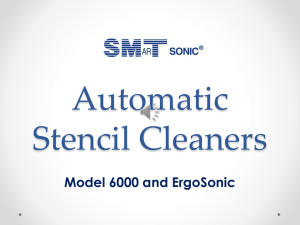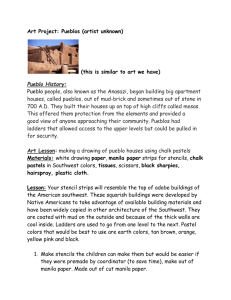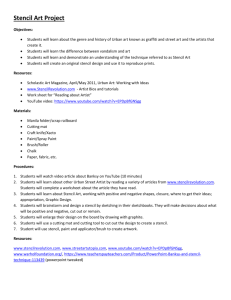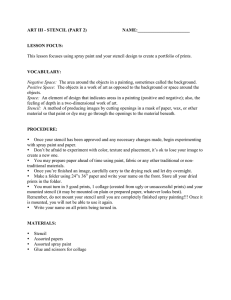PatchWork® stencil Laser cut step stencil, step-up/step
advertisement
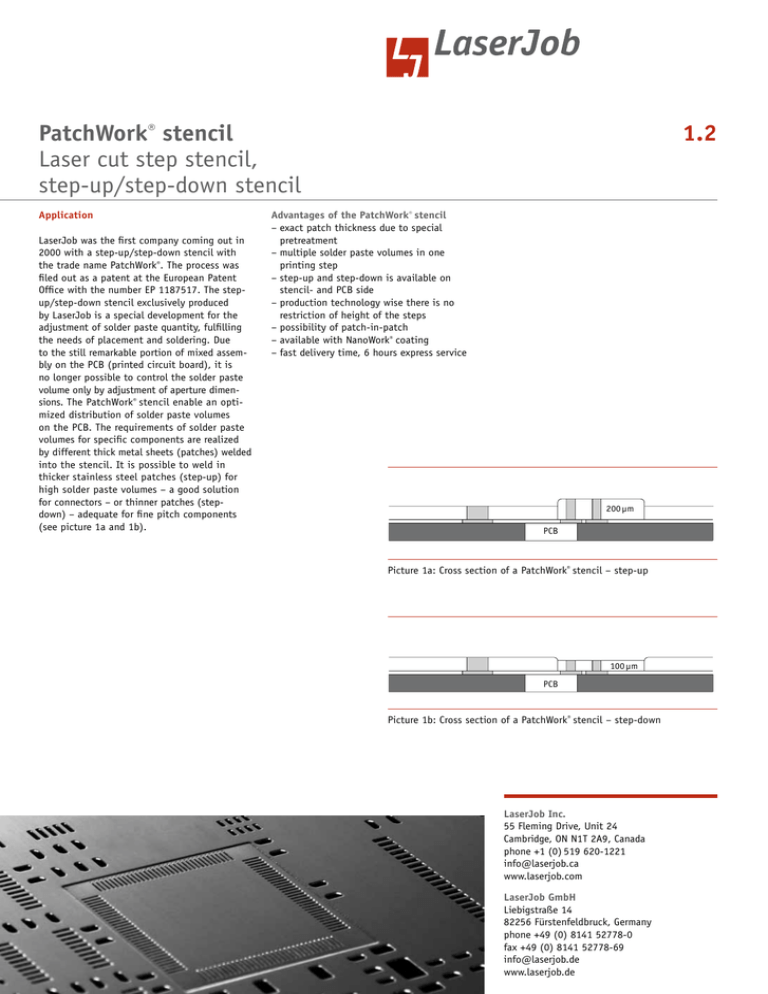
PatchWork® stencil Laser cut step stencil, step-up/step-down stencil Application LaserJob was the first company coming out in 2000 with a step-up/step-down stencil with the trade name PatchWork®. The process was filed out as a patent at the European Patent Office with the number EP 1187517. The stepup/step-down stencil exclusively produced by LaserJob is a special development for the adjustment of solder paste quantity, fulfilling the needs of placement and soldering. Due to the still remarkable portion of mixed assembly on the PCB (printed circuit board), it is no longer possible to control the solder paste volume only by adjustment of aperture dimensions. The PatchWork® stencil enable an optimized distribution of solder paste volumes on the PCB. The requirements of solder paste volumes for specific components are realized by different thick metal sheets (patches) welded into the stencil. It is possible to weld in thicker stainless steel patches (step-up) for high solder paste volumes – a good solution for connectors – or thinner patches (stepdown) – adequate for fine pitch components (see picture 1a and 1b). 1.2 Advantages of the PatchWork® stencil –exact patch thickness due to special pretreatment –multiple solder paste volumes in one printing step –step-up and step-down is available on stencil- and PCB side –production technology wise there is no restriction of height of the steps –possibility of patch-in-patch –available with NanoWork® coating –fast delivery time, 6 hours express service 200 µm PCB Picture 1a: Cross section of a PatchWork® stencil – step-up 100 µm PCB Picture 1b: Cross section of a PatchWork® stencil – step-down LaserJob Inc. 55 Fleming Drive, Unit 24 Cambridge, ON N1T 2A9, Canada phone +1 (0) 519 620-1221 info@laserjob.ca www.laserjob.com LaserJob GmbH Liebigstraße 14 82256 Fürstenfeldbruck, Germany phone +49 (0) 8141 52778-0 fax +49 (0) 8141 52778-69 info@laserjob.de www.laserjob.de PatchWork® stencil Laser cut step stencil, step-up/step-down stencil Patch-in-patch application A specific application of the PatchWork® stencil is the patch-in-patch option. This technology is always recommended for soldering two interconnection levels of one component. A QFP component with solderable heat sinks is a typical example for patch-in-patch application (see picture 3). In an extremely small area of less than 340 mm² two different thick stainless steel sheets were welded in one another. In our example shown in picture 2, the basic thickness of the stencil represents 150 µm, the patch of the QFP structure 120 µm and the patch in the patch for the heat sink interconnection 180 µm. Special application: Step-down on the PCB side This special application of the PatchWork® technology is characterized by a Step-down on the PCB (printed circuit board) side of the stencil. The technology is used to hide thick labels on the printed circuit board, by welding in the stencil a thin stainless steel sheet (patch without any apertures) (see picture 2). Bar code label PCB Picture 2: Cross section of Step-down on the PCB side Patch-in-patch step stencil Standard foil thickness: t = 150 µm heat sink interconnections: t = 180 µm QFP: t = 120 µm Pitch: 400 µm Aperture width: 200 µm Distance: 700 µm 120 µm 180 µm Picture 3: QFP with heat sink for soldering interconnections Production technology In air conditioned working rooms a pulsed laser cuts an opening in the required size of the patch/step in the stainless steel sheet. Afterwards an accurately fitting patch is welded in the stencil in the desired thickness. LaserJob uses only pretreated stainless steel sheets for the patches to guarantee exact patch thicknesses and exact solder paste deposits. After the welding process the apertures are cutted in the patch and stainless steel sheet in one production step (see picture 4). The stainless steel stencils from LaserJob show a more efficient solder paste release due to the lightly conical apertures which are formed by the characteristic of the laser beam. To produce true to size stencils it is necessary that the laser cutting process takes place in strained condition. All laser cut stencils from LaserJob undergo afterwards a brushing process. With a CNC-controlled brushing system the cutting burrs on the laser exit side are removed. The brush head moves in all four directions meandering over the whole area. The dimension of the apertures is not affected. Step 1: Laser cut of patch Picture 4: Schematic production flow Patch thicknesses are available in 10 µm steps until 300 µm. For solder paste printing process standard stainless steel squeegees are common used, closed squeegees systems can be used without problems up to steps with a height more than 50 µm. The PatchWork® patent from LaserJob with all around welded stainless steel patches guarantees high accuracy and precise solder paste volumes. Advantages of PatchWork® production technology: –smooth transition on the patch edges –high flexibility in design variations –belated insertion of patches also with changed patch thicknesses (step-up and step-down) in existing stencils Step 2: Welding of patch inside the stencil Step 3: Cutting the apertures into patch and stencil www.laserjob.com Fulfillment Material Stainless steel 1.4301 Hardness (Hv): min. 370 Tensile strength [N / mm2]: > 1100 Thickness of metal sheets: ± 3 % Dimensions of stainless steel materials PatchWork® stencils are available in metal sheet thicknesses of (µm): 20, 30, 50, 70, 80, 90, 100, 120, 130, 140, 150, 180, 200, 250, 300, 400 PatchWork®-stencils in VectorGuard tensioning systems are available in metal sheet thicknesses of (µm): 80, 100, 130, 150, 180, 200, 250 Maximum thickness of metal sheets: 2 mm Maximum machine surface: 800 mm x 600 mm Variances –combination PatchWork®-stencil with NanoWork®-stencil –stencil in screen printing frame glued over stainless steel mesh –in tensioning system LJ 745 –in Quattroflex tensioning system –in VectorGuard® tensioning system – in Alpha Tetra/ Micromount / Vector tensioning system –in ZelFlex tensioning system –in Stencilman tensioning system –in different customer-specific tensioning systems Frames –aluminum frames –aluminum casting frames –stainless steel frames For information on the size of the frames see 1.4 Frames and Tensioning systems LaserJob data sheets 1.0 SMD stencil 1.1NanoWork® stencil 1.2PatchWork® stencil 1.3 Tensioning system LJ 745 1.4 Frames and tensioning systems 1.5 Repair and Re-balling stencil 1.6 Wafer bumping-stencil 1.7 LTCC Via fill-stencil 2.0 Laser Material Processing 2.1 Laser ablation Auch in Deutsch erhältlich. As of 10 / 2013 © LaserJob Inc. The screen cloth is made from stainless steel with high accuracy of meshes. The supply form of the standard stainless steel screen cloth is 80 mesh, wire diameter 0.1 mm. On request it is possible to supply the stencils with a screen filler. The screen filler avoids the contamination of the screen printer machine and the screen cloth. Service LaserJob offers a full range consulting service for layout and design. Our team generates from your CAD-CAM data automatic cutting instructions for the laser. Our highly focused laser systems cut with high positioning accuracy the apertures. We offer additionally –scaling apertures up and down –changing aperture design, e.g. homeplates and rounding sharp corners –optimizing apertures (anti tombstone design) –rotating or mirroring of the whole design or sub areas –controlling of aspect- and area ratios –generation of stencils with multiple panels –generating layouts from existing PCB’s –generating stencils layouts for adhesive application –customer specific storage for used frames. The frames will be cleaned, restringed and provided for new orders. Your actual inventory is always recallable. –data storage –test certificates (as well as customer’s specification) –data for solder paste inspection systems –measuring of printed circuit boards –production of stencils from provided PCB’s, stencils or films Shipping conditions Shipping time Standard shipment time ex works is 3 work days Order entry before 5 p.m. (= first work day) 24 hour express shipment – Confirmed orders will be shipped the next day Order entry before 1 p.m. 6 hour express shipment – Confirmed orders will be shipped the same day Order entry before 1 p.m. Common carrier: UPS, DHL, GO, FedEX (any shipping service) as well as direct shipments with courier delivery with partner companies. Packaging All LaserJob stencils are shipped in reusable packaging. To avoid damage of stencils, proven packaging materials are used. We deliver stencils in specialty packaging as well as per customer request. For stencils in tensioning systems a special storage bag is recommended. Order process To guarantee a fast handling of your order, send the purchase order via –e-Mail: mail@laserjob.ca –post Please send the gerber files for the stencils via e-mail to: mail@laserjob.ca
